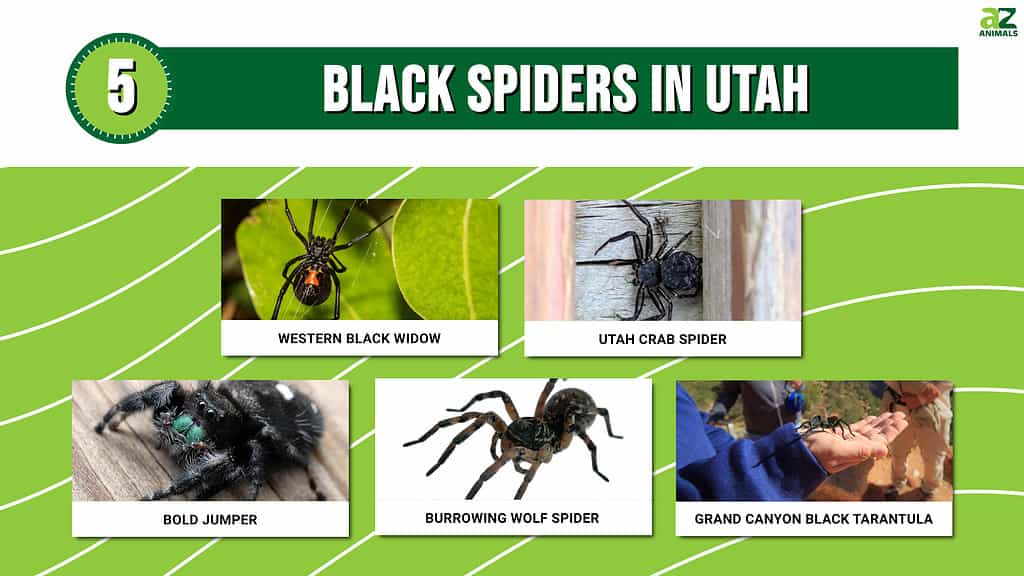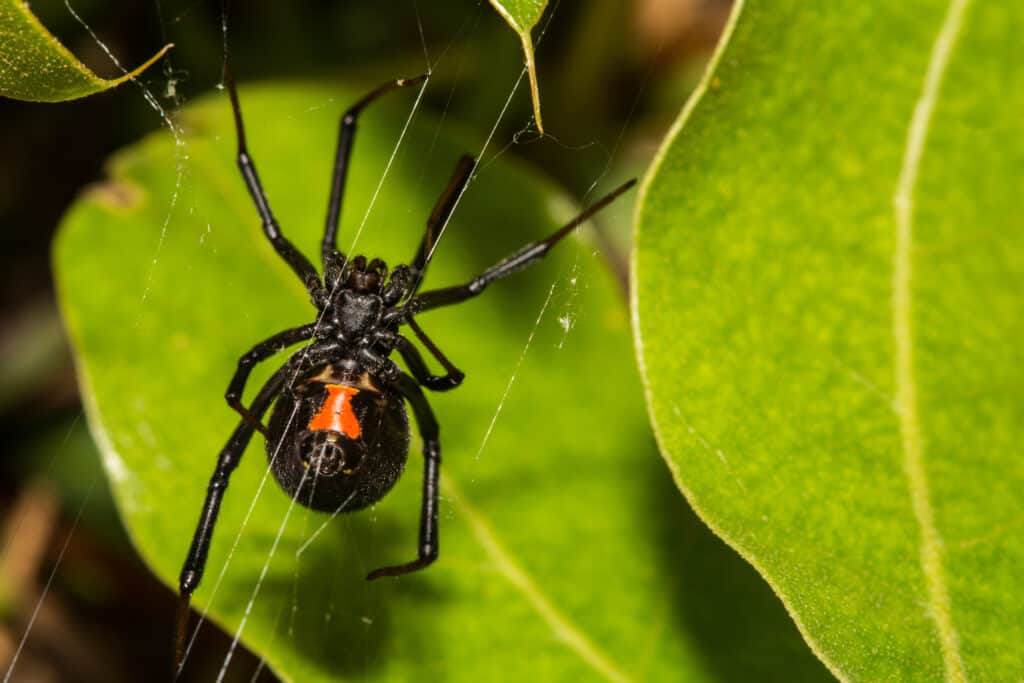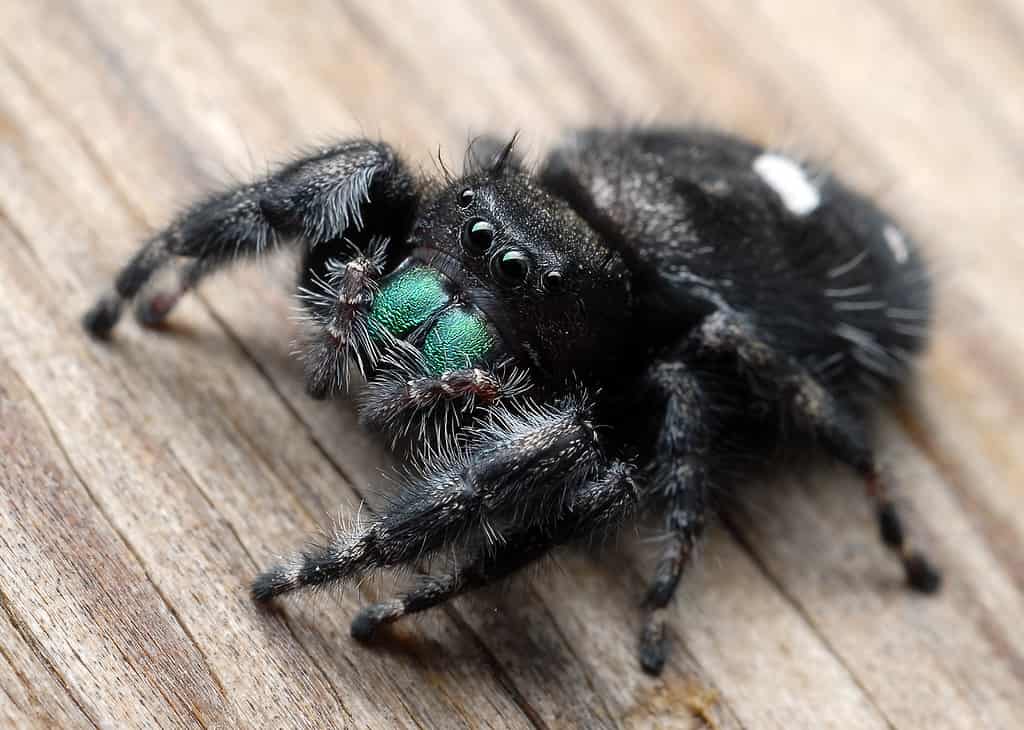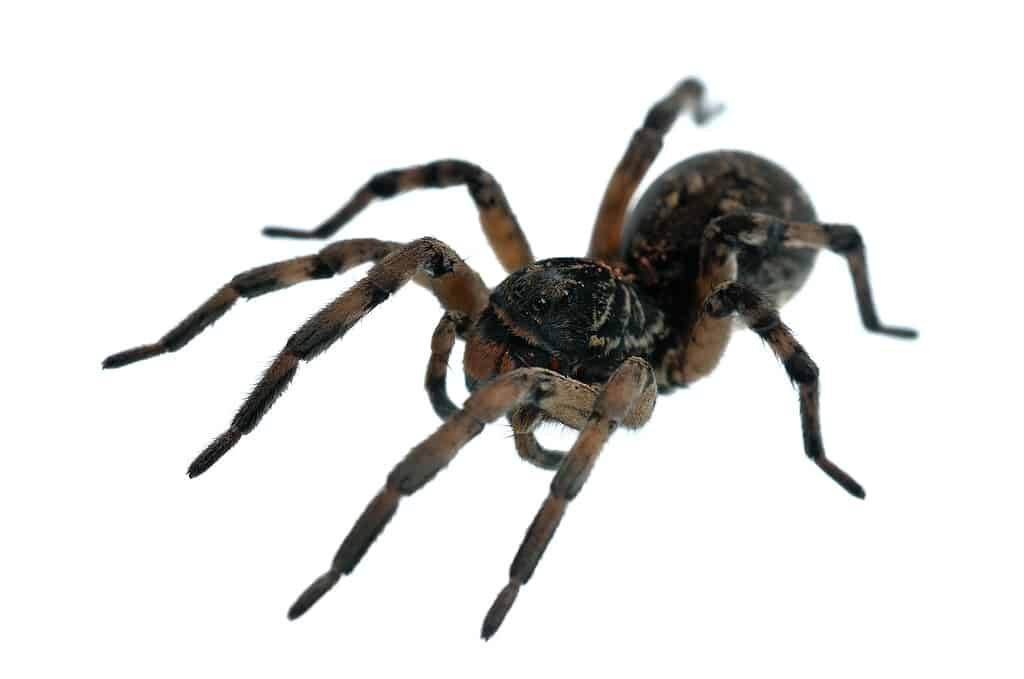There are several black spiders in Utah, specifically Western black widows, Utah crab spiders, bold jumper, burrowing wolf spiders, and Grand Canyon black tarantulas. While most of these spiders look dangerous, not all of them are. In fact, spiders like the tarantula are quite docile. These five spiders occur throughout the state and often wander into people’s homes. So, if you are curious about black spiders in Utah, continue reading.

Western Black Widow

It is easier to identify the black widow females because of their shiny black bodies, with a red hourglass-shaped marking on the underside of their abdomen.
©Jay Ondreicka/Shutterstock.com
It is common for male and female spiders to look different, and the black widow is no different. While there are five species of black widow, all of them have males and females that differ in appearance. For example, it is easier to identify the females because of their shiny black bodies, with a red hourglass-shaped marking on the underside of their abdomen. However, males are half the size of females and lighter in color, with red or pink markings on their abdomens.
These dangerous spiders are primarily found in southern and western states and occur in forests, grasslands, deserts, and urban areas. Black widows like staying in places with high populations of people because there are usually thousands of insects to feed on. In addition, they prefer to spin their webs in dark corners of buildings. Females are more dangerous than males because their size allows them to inject more venom when they bite. Their venom is 15 times more potent than a rattlesnake‘s, but their bites aren’t as severe because they deliver less venom than snakes. However, this does not mean their bites aren’t painful. Furthermore, their bites pose serious risks to children and seniors with compromised immune systems.
Utah Crab Spider

Utah crab spiders don’t spin webs; they are ambush predators.
©Dirkvent / CC BY-SA 4.0 – License
Another black spider in Utah is the crab spider, which derived its name from its crab-like legs. These spiders occur all over Utah; people often see them on plants where they hunt for prey. However, unlike most spiders, Utah crab spiders don’t spin webs; they are ambush predators. In addition, there are some species of crab spider that can change color, like the goldenrod crab spider. They also inhabit grasslands, gardens, and meadows. Utah crab spiders pose no harm to humans. Instead, they benefit humans by eating mosquitos and other insects that annoy us.
Bold Jumper

Jumping spiders do not spin webs but actively hunt for prey.
©Miles Boyer/Shutterstock.com
The bold jumper (Phidippus audax) is one of the most commonly sighted jumping spiders in the beehive state. These spiders are members of the Bassaniana genus, which are a group of bark crabs primarily found near trees and other wooden structures. These jumping spiders do not spin webs but actively hunt for prey. They are tiny spiders, so their bite is not dangerous; they pose no threat to humans.
Burrowing Wolf Spider

Wolf spiders come in a variety of colors, like black, tan, gray, and brown, with dark markings.
©D. Kucharski K. Kucharska/Shutterstock.com
Burrowing wolf spiders belong to a family of large, athletic, and hairy arachnids. Like many species on this list, these spiders don’t spin webs; they chase their prey. Wolf spiders occur all over the world and throughout the USA. They are especially common in meadows and grasslands. However, they also inhabit deserts, wetlands, mountains, and rainforests, basically anywhere with large numbers of insects.
Wolf spiders come in a variety of colors, like black, tan, gray, and brown, with dark markings. These massive spiders will bite if they feel threatened. Luckily, their venom isn’t dangerous to humans; it’s about the equivalent of a bee sting. They will only bite someone who is mishandling them or if they get trapped next to the skin. Bite symptoms can include swelling or redness, but that’s the extent of it. There are no reports of severe medical problems caused by a wolf spider bite. But this does not mean you should try to handle them; their bites still hurt. Furthermore, people often confuse brown wolf spiders for the highly venomous brown recluse spider, especially ones found in homes. If you see a fast-moving spider on the ground, it’s likely a wolf spider because brown recluse spiders are incredibly shy and rarely seen in the open.
Grand Canyon Black Tarantula

Black Tarantulas occur in various habitats like sagebrush steppe and mixed conifer forests.
©Losonsky/Shutterstock.com
The Grand Canyon black tarantula inhabits elevated areas in the “Four Corners” region of southwestern Colorado, southeastern Utah, northern Arizona, and northwestern New Mexico. They occur in various habitats like sagebrush steppe and mixed conifer forests. While these spiders are very common in the Four Corners, they are rarely seen because they remain hidden in their burrows. Furthermore, their burrows are incredibly hard to find. While these tarantulas aren’t dangerous, they deliver a painful bite. There are many people that keep them as pets, and even though they are big, they are easily injured, especially when dropped or stepped on.
The photo featured at the top of this post is © Sari ONeal/Shutterstock.com
Thank you for reading! Have some feedback for us? Contact the AZ Animals editorial team.






